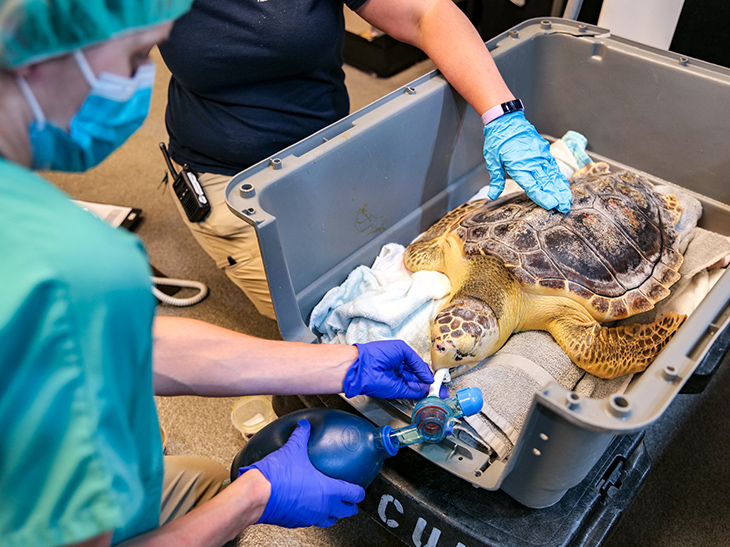We are SOLD OUT of tickets for today, Saturday July 5th.

BOSTON, MASS. (Dec. 14, 2023) – A new study from the New England Aquarium is highlighting the potential role of surgically-implanted acoustic transmitters in sea turtle conservation, as scientists focus on better understanding and protecting this vulnerable species group globally.
**PHOTOS AND VIDEO AVAILABLE HERE WITH CREDIT TO NEW ENGLAND AQUARIUM**
The Aquarium has been engaged in sea turtle rescue, rehabilitation, and research for 30 years. Its Sea Turtle Hospital in Quincy, MA, is a world-class facility that has successfully rehabilitated thousands of sea turtles and returned them to the ocean. A few years ago, Aquarium scientists and veterinarians developed a proposal to surgically implant acoustic transmitters in loggerhead sea turtles, carefully detailing the procedure, recovery timeline, and criteria for releasing the turtles.
Researchers use acoustic telemetry to collect information about the movements of ocean animals. The transmitters are electronic tags that broadcast a series of “pings” or sound pulses into the surrounding water. These transmitters ping listening stations like an E-ZPass system when an animal passes by.
Based on the Aquarium’s specialized facility and expertise, the U.S. Fish and Wildlife Service granted the Aquarium a federal permit to conduct a pilot implantation study with 15 hospitalized loggerhead sea turtles that had been successfully rehabilitated after stranding in Massachusetts. This first-of-its-kind study was recently published in the journal Animal Biotelemetry.
“Acoustic telemetry is an important and widely used tool for the study of sea turtle biology. However, externally-attached acoustic transmitters are prone to premature detachment in some cases. These internal transmitters can last for three to over seven years, providing valuable long-term information on where the turtles swim, feed, and travel,” said Dr. Kara Dodge, a research scientist in the Anderson Cabot Center for Ocean Life at the New England Aquarium.
The surgical procedures were completed by the Aquarium’s veterinary team in 2021 and 2022, and turtles were monitored for two to three months following surgery before being released into the ocean. Twelve of the turtles healed without complication, while two required a second surgery and a third had its transmitter removed to promote healing. To date, 100 percent of the turtles released with functional acoustic transmitters have been detected over 1,300 times by acoustic receivers off the coasts of Massachusetts, Rhode Island, Connecticut, New York, Virginia, North Carolina, South Carolina, Florida, and in southern New England offshore waters.
“This technique has potential to inform us about a turtle’s location for many years—much longer than other available methods. The information that we gain will help us to better understand how sea turtles use New England waters, which is important for establishing effective conservation policies. It will also allow us to understand the long-term fate of the many turtles that we rehabilitate each year,” said veterinarian Dr. Charles Innis, the study’s lead author.
The seven species of sea turtles are of global conservation concern due largely to negative impacts of fisheries interactions, habitat loss, vessel collision, pollution, disease, and extreme weather events. Efforts to rehabilitate and research sea turtles contribute to maintaining future breeding efforts and expanding the population size.
Eighteen Aquarium employees contributed to the pilot study, which was funded in part by the Arthur L. & Elaine V. Johnson Foundation. The study was approved by the U.S. Fish and Wildlife Service as part of Permit Number ES69328D. Many federal, state, and nonprofit organizations provided data for the Aquarium’s study.
MEDIA CONTACT: Pam Bechtold Snyder, psnyder@neaq.org; 617-686-5068
